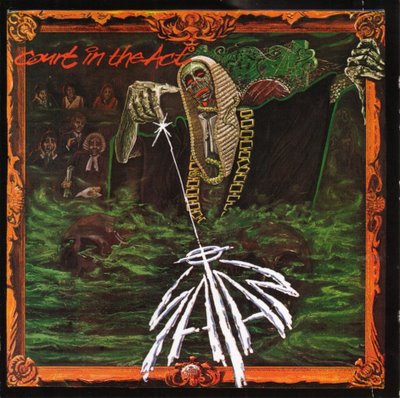Satan
Court in the Act (1983)

The late 1970s and early 1980s was a time of rapid change and was characterised by increasing political disquiet and the creeping spread of neo-liberal policies (with their promises of hope and riches that never came for most). Influenced by this social unrest new forms of music formed within the established popular music genres and expressed their anger and disillusionment at the system. Post-punk and New Wave were thriving as new forms of rock and punk music, and of course the hard rock / early Metal of the 1970s was coalescing and evolving into something ever more fierce and violent. Court in the Act was such an album, stemming from the angry working classes of Britain, with that feeling of steel and grit from the factories and also from the void left behind after their increasing disappearance under the weight of structural economic change.
In simplistic terms, and obviously this does not tell the whole story, Satan took the burgeoning speed and classy dual-guitar melodicism found on Judas Priest’s albums like Stained Class and took it to a whole other level. The production comes across at first impression as fuzzy, muffled, with some reverb and a bit lacking in clarity. However with repeat listening there is a fiery edge that comes to the fore, brazen and unrestrained. It is the kind of album for which a slick production job would be a detriment. The fact that it is gritty and dirty is perfect. The songs themselves are anthems for the dispossessed, using references to historical events (past wars and invasions) as metaphors for the oppression of the common man and also his violent retaliation against the corrupt system. Common themes of the songs therefore revolve around the dynamics surrounding the relationship between Oppressor and Oppressed, and actions like Invasion and Resistance/Vengeance.
This music is pretty much the missing link between the faster Hard Rock and Metal of the 1970s and the Thrash/Speed Metal to come. Whilst the foundations of these songs are verse/chorus arrangements, you would be forgiven for thinking this is not the case due to the free-willed, "impromptu" feeling of the musicianship. The dual guitars are wild and fierce, perhaps coming off as messy due to the riffs being full of rapid scale runs and an often unpredictable or loose structure. There are enough extended bridge sections and segues that this structure does not feel limiting at all and is often hardly noticeable (especially in songs like Alone in the Dock) and most songs have multiple riffs in the verses. There are also a lot of wonderful melodic ideas and solos and the tempo often slows down a few cogs to provide breathing space in which these ideas can develop.
The vocals have a fairly limited range, flat sounding at times, but more importantly for this type of music they are full of energy and intent and perfect for this kind of guitar orientated affair. Where needed, most particularly in the choruses, they offer succinct and catchy hooks, adding memorability to the songs. The bass is mostly audible and different to a lot of later Metal where the bassist often gets buried in a muddy mess or sounds like a truck. As such the bassist is free to interact with the guitar at times, as was common in this era. Combined all of this provides an explosive cocktail of NWOBHM music and a glimpse into the trajectory of the Metal to come.
The vocals have a fairly limited range, flat sounding at times, but more importantly for this type of music they are full of energy and intent and perfect for this kind of guitar orientated affair. Where needed, most particularly in the choruses, they offer succinct and catchy hooks, adding memorability to the songs. The bass is mostly audible and different to a lot of later Metal where the bassist often gets buried in a muddy mess or sounds like a truck. As such the bassist is free to interact with the guitar at times, as was common in this era. Combined all of this provides an explosive cocktail of NWOBHM music and a glimpse into the trajectory of the Metal to come.

Comments
Post a Comment